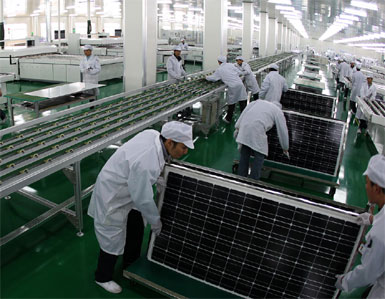Although we tend to think of the solar industry as "all good for the environment," some companies score much better than others in the 2014 Solar Scorecard.
While the industry’s end product is clean electricity – in stark contrast to fossil fuels – manufacturing, reporting and other aspects of the business vary among solar manufacturers. To make solar panels, unfortunately, there are still some pretty toxic chemicals involved. Are they reducing them? Finding alternatives? And what happens with emissions and waste?
For the fifth year, the Silicon Valley Toxics Coalition (SVTC) ranking exposes differences based on environmental and social justice factors, including water use, worker rights and health & safety on the job.

For one thing, the industry is increasing turning to contract manufacturers, which now account for over 25% of the global PV supply – "white box" suppliers who could drive a race to the bottom. SVTC is concerned that companies who offer cheap products and hide their environmental footprint may be rewarded by the market, says Sheila Davis, executive director of Silicon Valley Toxics Coalition.
Outstanding Solar Manufacturers
The top 5 solar companies and their (scores – 100 points is the highest):
- Trina Solar (scored 92)
- SunPower (88)
- Yingli (81)
- SolarWorld (73)
- REC (71)
Looking across the five years of SVTC’s analysis, SolarWorld and Yingli have consistently scored the highest, despite significant disruptions in the industry. SunPower has earned Cradle to Cradle® Silver Certification for some PV modules.
Solar companies with the lowest scores (less than 10 points): Hareon Solar, Jinko, Miasole, Suniva, Hyundai, Gintech, NBSolar and Andalay Solar.
10 out of 37 companies have annual targets for reducing hazardous waste, and SolarWorld, Yingli, REC and Sharp disclose and report on all chemical emissions during manufacturing. 13 companies report on one or more categories of emissions: hazardous waste, heavy metals, air pollution, ozone depleting substances and/or landfill disposal.
Trina, Yingli and Up Solar have written letters to the Solar Energy Industries Association (SEIA) seeking action on recycling for PV modules in the US, and 14 companies say they would support a US producer takeback law.
Although no solar company can verify the absence of "conflict minerals" in its supply chain, 12 are in the process of due diligence.
"It’s critically important for companies to collect and report chemical use and emissions data," said Assistant Professor Dustin Mulvaney of San Jose State University, SVTC’s science advisor. "The more transparency there is on this issue, the more likely it is that companies will be able to compete to reduce their emissions per PV module."
Environmental Leadership Standard for Solar PV Panels
The next step for SVTC is to develop a standard that can be used to compare solar suppliers and objectively evaluate their performance, in a way that meets the criteria of the American National Standards Institute (ANSI) and EPEAT Registry.
The group is developing it over the next 12-24 months in concert with solar and green procurement leaders, and fellow nonprofit, Green Electronic Council.
"Environmental procurement is greatly simplified when performance criteria are codified in credible leadership standards," says Robert Frisbee, CEO of the Green Electronic Council.
"We need to take action now to reduce the use of toxic chemicals in PV, develop responsible recycling systems, and protect workers throughout the global PV supply chain," says SVTC.
- Takes responsibility for the environmental and health impacts of its products throughout their lifecycles, including adherence to a mandatory policy for responsible recycling.
- Implements and monitors equitable environmental and labor standards throughout product supply chains.
- Pursues innovative approaches to reducing and work towards eliminating toxic chemicals in PV module manufacturing.
Learn more about the 2014 Solar Scorecard:

